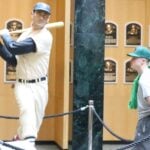
The Pittsburgh Pirates made an offer to acquire perhaps the greatest hitter who ever lived, Ted Williams, in 1937. They may have gotten “The Splendid Splinter,” too, were it not for a dispute over a light bill. So said Pie Traynor to Jimmy Jordan of the Pittsburgh Post-Gazette in 1958.
Pirates History Lookback: Dispute Over Light Bill Cost Pittsburgh Ted Williams
To say Williams could hit is like saying Caruso could sing. For his career, all with the Boston Red Sox, Williams hit .344/.482/.634, 521 HR, and 1,839 RBI. Read that OBP again. It’s an all-time career record. For 19 years, he reached base almost half the time he stepped into the batter’s box. He had a 191 OPS+ and was worth 121.8 WAR. He was worth two wars to his country, too. Williams played from 1939-60, interrupting his career to fight in World War II from 1943-45 and the Korean War from 1952-53. Otherwise, he may have broken Babe Ruth’s career home run record before Henry Aaron.
Williams won six American League batting titles and was the last player to hit .400 in a season when he hit .406 in 1941. He finished second in the AL Most Valuable Player Award voting that year to Joe DiMaggio. That was the year DiMaggio captivated the nation with his 56-game hitting streak. During his famous streak, DiMaggio hit .408/.463/.718. Even during that period, however, Williams was the better hitter, hitting .412/.540/.685. Williams received MVP consideration every year (winning the award in 1946 and 1949) except 1952. He was named to the AL All-Star team every year save for 1939 and 1952. Of course, he appeared in just six games in 1952.
Traynor was the Pirates third baseman from 1920-35 and manager from 1934-39. In his day, only Honus Wagner was a bigger star in the Pittsburgh sports world. Although he was born in Farmington, Massachusetts, Traynor remained in Pittsburgh when his baseball career was over. He was a familiar face on local TV’s popular Studio Wrestling during the 1960s, doing live commercials for American Heating. (“Who can? Ameri-can!”)
“Williams Hit a Long Ball”
As Traynor recounted the story to Jordan, the Pirates, who conducted spring training in San Bernadino, California, played an exhibition game in San Diego against the Padres of the Pacific Coast League. Traynor remembered that Williams was in left field for San Diego and their manager was “Hard Rock” Lane. It was a night game. Traynor told Jordan, “[Lane] wanted the Pirates to pay half of the light bill, but the Pirates told him it was their home game, and they’d have to pay the light bill.
“Well, Williams hit a long ball and right away I thought we could use him. But when I asked Hard Rock about buying him, he was still mad about the light bill, and we couldn’t get him.”
Then-Pirates president William Benswanger had a different story. He said the Red Sox had an option on Williams anyway. Traynor had a reputation for telling tall tales. But the evidence supports Traynor’s version.
Pirates Face Young Williams
It was indeed a night game on April 1, 1937, won by the Pirates, 7-3, although Williams didn’t play in the field. Williams pinch-hit for pitcher Miguel Salvo in the sixth inning. The box score shows that he was 0-for-1. Probably the “long ball” Traynor saw was a deep fly out. Williams didn’t appear in the next evening’s game, which was also won by the Pirates, 10-2.
The newspaper accounts don’t mention Traynor making a play for the then-unknown Williams. They report that Traynor was similarly rebuffed when he made a generous offer for Padres pitcher Tiny Chaplin, who had previously pitched for the Boston Bees and New York Giants.
“The Best Hitter to Come Up to the Majors in Years”
However, by the fall, the Pittsburgh media certainly knew who Williams was. Wrote Chester L. Smith, sports editor of The Pittsburgh Press, in a column of random thoughts separated by dots, a popular format of the time:
“Peg this . . . The best hitter to come up to the majors in years will be Ted Williams of San Diego . . . The scouts say he is as good as [Rogers] Hornsby or Ruth . . . He’s [a] left-handed batter . . . Williams is 19 . . . And every club in the big time, including the Pirates, is breaking its neck in the bidding.”
After Williams hit .292 with 23 home runs for the Padres in 1937, the Red Sox purchased him in December. Contrary to what was suggested by Benswanger, who may have been trying to save face over his refusal to share the light bill, the Red Sox held no option on Williams. The Bosox had to outbid several teams, including the New York Yankees, who offered $35,000 (worth $767,000 today). They pried Williams from the Padres for three players and an undisclosed amount of cash. Reported the Associated Press, “If anyone insisted on awarding a ‘money spending’ blue ribbon for activity during the 1937 major league baseball meetings, it would have to be pinned on the gilt-edged Boston Red Sox.”
What Might Have Been
Getting back to 1958, Traynor revealed to Jordan that around that same time, the Pirates had also passed on DiMaggio and Stan Musial. DiMaggio had a bad knee, which scared the Pirates away. “Stan the Man” had a tryout at Forbes Field as a pitcher and didn’t impress. “I wonder what those three fellows [including Williams] would have done for the Pirates if they were all playing together at the same time,” lamented Traynor.
Main Photo Credits: Brandon Brown/Seacoastonline / USA TODAY NETWORK
The post Pirates History Lookback: Dispute Over Light Bill Cost Pittsburgh Ted Williams appeared first on Last Word On Baseball.
